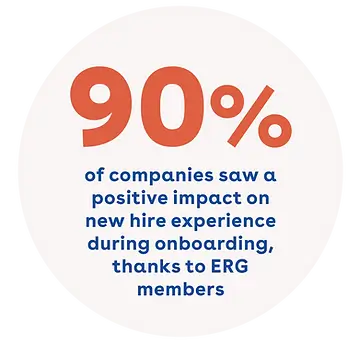Have you ever celebrated a heritage month at work? No matter how you’ve celebrated — whether you’ve participated in a volunteer activity to support a particular community, a group outing to a Pride parade, or something else — ERGs, or employee resource groups, may have organized the effort. Bringing awareness to their community is only one facet of what ERGs do. They also create a space for people within that community to actively support each other in the workplace.
How can People Ops leaders best support these groups, so that they thrive within your organization? Below, we get expert input from Ethena’s Vice President of People, Melanie Naranjo on just this.
What are ERGs?
An employee resource group (or ERG) is an employee-led group that's formed by individuals at an organization who share interests, backgrounds, or key identities like sexuality, race, or ethnicity. ERGs are formed by employees to build community, elevate voices, bring awareness, and more. What’s crucial to understand about ERGs is the fact that they’re not meant to be spearheaded by an employer. An employer should provide support for ERGs, but the groups must be formed and led by employees. The reason being is if not, you’ll risk the group feeling forced or overly prescriptive. It’s kind of like when you were a kid and your mom was trying to pair you up with a new “friend.” She said, “Ok, now have fun!” But really, you both stared at each other awkwardly due to this new, “forced” relationship.
"As much value as ERGs bring to companies and employees alike, an ERG that is driven by the employer rather than an employee is going to miss the mark every time." –Melanie Naranjo, Ethena’s VP of People
“As much value as ERGs bring to companies and employees alike, an ERG that is driven by the employer rather than an employee is going to miss the mark every time,” notes Melanie Naranjo, Ethena’s VP of People. “The goal is to learn from and listen to our employees, not have the employers drive or dictate how best to support a community.”
This also means that employees must be willing to invest the time and energy to make an ERG work. “Wanting ERGs isn’t the same thing as forming them,” Naranjo says. “If no one is willing to step up to do it, you have to be honest with employees about limitations.”

Types of ERGs
Some of the most common ERGs are diversity resource groups for employees who share the same:
- Racial background
- Gender identity
- Ability status
- Sexual orientation
ERGs can also encompass volunteer groups, affinity groups, or other professional development groups. However, the most common types of ERGs within organizations are diversity resource groups.
Purpose and benefits of ERGs
At the very core, ERGs improve employee engagement and experience within a company. They’re an avenue for employees to connect with colleagues who have similar backgrounds, demographics, and experiences as them. Top benefits of ERGs include:

- They help people grow more confidently and equitably. Within one, employees can (and should!) talk to each other about how to ask for a raise or promotion. They should be networking with each other and pairing up for peer coaching and mentorship. Some of the best ERGs partner with executives and HR to learn more about different career paths, growth opportunities, career advice, etc. One example is inviting a different executive to share their career trajectory within the ERG once per month.
- A sense of belonging. It’s unfortunate, but employees do feel lonely at times within companies. Some scenarios include:
- Being the first in their family to enter the corporate workforce and to struggle with the challenges associated with their unique cultural upbringing and abilities.
- A woman with the opportunity for a leadership position, but who is second guessing herself and her decisions, and is nervous if she should ask for the promotion.
- A parent who is juggling “sick kid days” and volunteering for kid field trips, but is unsure if that shows up in the corporate environment as “not committed enough.”
- This sense of belonging feels like showing up to a Halloween party, and suddenly realizing you’re the only one who wore a costume. But then you look across the room and see (thankfully!) someone else wearing a costume too. Now you breathe a sigh of relief since you don’t feel so alone and out of place. Of course, you’ll most likely go to that person and chat during the Halloween party because just like an ERG, you both have something in common.
- Improved retention. An independent study conducted by Shelton Goode, director of Diversity & Inclusion at Oshkosh Corp., found that 90% of studied companies saw a positive impact on new hire experience during onboarding, thanks to ERG members. A better experience in the first 60 to 90 days of employment can lead to longer-term retention — a win-win for both employee and employer.
- Organizational change. Since ERGs are led from within, employees can work as a unit to bring positive change. Whereas an individual employee might feel nervous about bringing an issue or suggestion to leadership on their own, ERGs give groups a voice and clear path to advocate for change.
- Show support for DEI. ERGs are a tangible aspect of diversity, equity, and inclusion — they show employees that people who look like them or share their experience are represented and celebrated. Not only is this simply the right thing to do, it also creates credibility for a company’s DEI efforts — which are becoming increasingly important to candidates. Being able to say “yes” when asked if you have ERGs can help you land top talent. An added benefit: As your ERGs grow, you can share information about them with future applicants on your careers page and social media.
How to support ERGs within your company
If your People Ops or HR team would like to support employees as they develop their own ERGs, Naranjo has a few tips on how to foster lasting success.
1. Help them set goals.
When someone wants to start an ERG, they may have ideas for what they want to do, but aren't clear on how to measure success. Start by asking an employee, “What is your end goal? How will you know if your ERG is successful?”
Once you help an employee fill in the holes in their ERG goals, get granular. Explore step-by-step what the ERG would need to accomplish to meet their initial goals, and what kind of time commitment would be required of each member to accomplish them. This discussion can help the group realize:
- Some goals might be too ambitious or not ambitious enough
- Some goals might need a budget or only minimal spend
- Some goals might require a partner from outside the ERG to achieve their plans
From there, you can collaborate with the employees to determine how human resources (HR) and leadership teams can partner with them and provide support along the way.
2. Support without taking over.
It’s natural for you to want the very best for an up-and-coming ERG (and perhaps get over-involved!) but remember: It’s not about you. It’s about what your employees who are a part of an established community want. Foster ERG independence while still providing support by:
- Making yourself available. Give examples to an ERG about the kind of support you can provide, but lean on them to dictate to you how much or how little they really want or need from you.
- Scheduling check-ins. Checking in with ERGs every so often ensures that there’s always time for the organization on your calendar if they need to utilize it. It’s also an excellent way to show that you value their input and want to partner with them on company-wide initiatives, too.
- Sharing information. Be proactive in sharing relevant company surveys or statistics with an ERG, like your company’s demographic representation. As events or all-hands meetings are planned, reach out to see if they’d like to earmark time to present any information to the entire team that relates to the ERG.
3. Think holistically about budgeting.
Once one ERG is founded, it’s likely others will follow. This is the overarching goal but get ahead of the game by thinking about the financial support and administration your company can realistically commit to for not just one, but multiple ERGs.
For your company’s first ERG, you may want to begin budgeting through approval requests for individual events rather than establishing a full budget from inception. That way, you can assess the ERG’s needs over time. Plus, support isn’t just monetary for an ERG — it can take many forms, like:
- Leadership access. Provide access to 1:1 coaching opportunities with senior leadership and ERG members. Use your position in People Ops to initiate those conversations.
- Project initiatives. Assign an executive sponsor to work with the ERG to create podcast discussion sessions or book clubs that center on relevant topics.
- Networking. Use connections in your network to find people who could be guest speakers for a virtual or live Q&A with workplace ERGs on relevant topics.
- Takeaways. ERGs are all about community building, leveling the playing field, and providing visibility across a company. Remember that you can create high-impact opportunities for ERGs without large budgets.
4. Manage membership thoughtfully.
As a new ERG gains traction in your company, it’s likely that allies may want to get involved, too. There are plenty of pros to making these groups private or exclusive so that members feel more comfortable speaking up and sharing their experiences in a safe space with their community.
However, the preference should always come down to what members of the ERG want, not what others want. As a leader, you may want to ask members during initial consultations what their plans will be for allies to support over time. Other tips to keep in mind to encourage ERG membership are:
- Clearly communicate eligibility and how to join. Advise ERG leaders to avoid leaning on personal invitations for employees to join an ERG. This helps avoid putting anyone on the spot or forcing people to rely on visual stereotypes. After all, you can’t tell how all people identify by just looking at them. Rather, make sure that the group is publicized and be clear that anyone who identifies as a member of the community is eligible to join the group at any time. Finally, ensure that there are clear instructions on how to do so.
- Provide instructions. When new employees decide that they want to join an ERG, provide clarity on how to do so, like by contacting an ERG lead.
- Don’t pressure anyone. Even if you think an ERG could benefit various employees, don’t push people from a community to participate in an ERG. They may have their own reasons for not wanting to join and that should be respected, too.
How to start an ERG
Whether you’re looking to start an ERG group for a community that you’re a part of or seeking to know how to support one in the process of formation, here are the steps our employees took to launch our first ERG, Black at Ethena:
- Talk about it. If you identify as part of a community that would benefit from an ERG, reach out to others in that community, and gauge interest.
- Get aligned. Draft a mission or vision statement and collaborate with your People/HR department for initial feedback.
- Get executive buy-in. Present the idea for your ERG to your leadership team with your established goals. While technically any group of employees could form an ERG without buy in, achieving certain goals would be difficult without their support and partnership. Gather and implement their feedback to work towards approval.
- Go back to the community. Formally establish the group and collaborate with your founding ERG members to determine your official name.
- Move forward. Work with your initial ERG members to develop a plan of action outlining your organizational mission, tangible goals, and roles.
- Reflect and adjust along the way. Your first iteration might not be as effective as you’d like. Use this as a learning opportunity and get better over time.
- Network with others. Finding folks who have successfully run or participated in ERGs can provide a wealth of wisdom. You can get lots of great tips from others who are already doing it.
ERGs are an important aspect of a diversity, equity, and inclusion strategy. Want to take DEI a step further at your company? Our DEI Course helps everyone understand, support, and celebrate coworkers with rising identities through compassion, intersectional awareness, thoughtful real-world examples, vivid comics, imaginative videos, and more. Talk to a member of our team to see if Ethena is right for your company.










